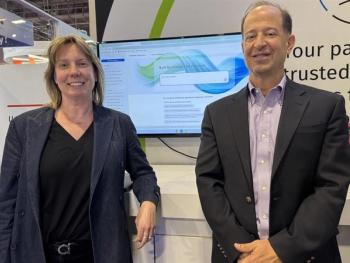
Healthcare Can't Achieve Value-Based Care Without an Intelligent Enterprise
Ad: How SAP supports critical data and analytics to create a 360-degree view of the patient.
A few months ago, members of the HIMSS Board of Directors traveled to Hamburg, Germany, to meet with pioneers who were busy shaping the future of data-driven healthcare. Werner Eberhardt, Ph.D., MBA, global head of healthcare for SAP, was one of those innovators. He took the opportunity to present his team’s strategy and technologies to create an Intelligent Enterprise, which is meant to provide healthcare organizations a comprehensive, data-driven view of their work. He described how SAP had built an enterprise system leveraging big data and advanced analytics to enable better patient outcomes and operational efficiencies, all in pursuit of healthcare’s monumental transition to value-based care.
“The more cost-efficiently a health system can provide a service, the more reimbursement it receives,” Eberhardt noted. “And the bottom line plays a key role in value-based care.”
But he also had a question for the HIMSS board: Did they know of a hospital that could monitor costs per patient, a basic capability in any other industry? HIMSS board members said they couldn’t identify such a hospital. Their answer was no surprise, as Eberhardt and his team had seen only modest success in this area and had never witnessed per-patient cost monitoring at scale.
The interaction was important because it touched on a larger problem in healthcare. Now that the first wave of electronic health record digitalization has crested, health systems must leverage all that data to innovate and improve their clinical and operational processes. As more data pour in from previously untapped or nonexistent sources, such as wearable devices and apps, the challenge will become steeper — and the rewards greater, Eberhardt told IDH Brand Insights. To succeed, health systems will need to access their data and analyze the information in context, using that foundation to adjust how they work and even build new intelligence services such as chat bots, robotics and automated systems.
“It doesn’t have to be our technology, but the Intelligent Enterprise has to happen for healthcare to transition to value-based care,” he added. “If they want to understand cost drivers and precision medicine, hospitals must really understand what is happening with a patient. They must have a 360-degree view of the patient.”
But what are the concrete, day-to-day benefits of an Intelligent Enterprise? Here are three examples of how cutting-edge data and analytics technologies can enhance the enterprise.
Building a Hospital Balanced Scorecard
When Parkland Health & Hospital System decided to create a hospital balanced scorecard, the Texas-based public health system hoped to identify unseen problems in care quality and costs. The organization strived to bust data silos that separate clinical and financial information and accelerate data delivery for improved decision-making capabilities.
Parkland worked with SAP on this project. SAP technologies agilely connected internal and external data sources and then powered real-time metrics through data visualizations. The content acted as a cockpit, enabling employees to see key performance indicators to guide daily and long-term operations, tailored to the individual through user-authenticated technologies.
Enhancing Transplant Care
In Berlin, Germany, Europe’s largest university hospital, Charité, resolved to better engage with patients who had undergone kidney transplantation surgery. After such a procedure, they sometimes developed unspecific symptoms like weight gain, increasing blood pressure or other conditions that signaled the body might reject the transplant. In that case, it’s critical for physicians and clinicians to intervene early — otherwise the patient could lose the organ.
So, Charité joined a consortium of healthcare stakeholders, including SAP, who strived to leverage technology to improve post-discharge engagement, in a project called Medical Allround-Care Service Solutions (MACSS). The innovators set out to build a patient-centered electronic healthcare service platform, first targeting kidney transplants, to increase drug safety and communications between patients and physicians. A mobile health app allowed for secure bidirectional data transfer, and MACSS used advanced memory databases to integrate patient data from other healthcare organizations and analytics to fuel personalized treatments.
While the initiative stands to produce better patient outcomes, it might also reduce healthcare costs in Germany over the long term.
“One of the largest health insurers is paying for this solution,” said Eberhardt, whose SAP technologies run MACSS. “It’s much more affordable for them to follow the patient closely before there are complications that require a new organ.”
Reducing Burden Through Diabetes Prevention
Type 2 diabetes affects patient quality of life and the financial well-being of the healthcare system. With millions of adults at risk of developing the chronic condition in the U.S. alone, SAP partnered with Roche Diabetes Care GmbH and turned to technology to strengthen prevention efforts.
The organizations produced a real-time information-sharing app called Accu-Chek View, comprising an SAP-developed app, which allows monitoring of parameters such as blood glucose, blood pressure, weight, steps and medication. The innovation enabled preventive medicine through continuous information sharing, a space for interactions between healthcare professionals (HCPs), and an online portal for HCPs to understand the patient’s health. Along the way, SAP Cloud Platform facilitated secure communications and data transfer.
A study found that Accu-Chek View users were six times more likely to achieve at least a 5 percent weight reduction in 12 months. What’s more, participants experienced a mean weight loss of 8 kilograms and an average body mass index reduction of 2.7 points.
It was yet another display of how digital technologies can drive better health outcomes — and how SAP technology can leverage data to improve patients’ lives.
Learn how
Dig Deeper







































